Curiosities of the Sinai
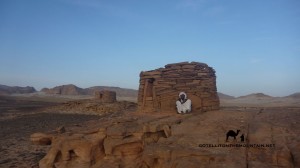
Modern Sinai is a huge treasure trove of wonderful curiosities; thanks mostly to its colourful past. Every settler group left their marks on the landscape; enriching and re-framing it in their own image before moving on and leaving the next group to do the same. Today, the Bedouin leave their marks too. All this stuff would’ve made perfect sense to whoever made it but seen today – and without explanation – it can befuddle the outsider. Here’s a quick guide to the signatures of the Sinai’s landscape; to the most common motifs you’ll see, in every region, and what they mean. Some you’ll spot easily; others are well hidden; so remember, keep your eyes peeled.
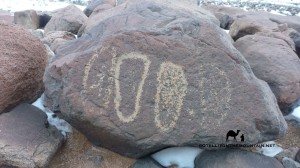 FOOTPRINT ROCKS – The Bedouin once used rocks for marrigae proposals. To propose, a man would scratch an oultine of his foot on to a rock. If the woman agreed, she’d scratch hers next to it (adding the little feet of any children if she’d been married before). If the marriage got the go-ahead from the two families, a big, celebratory circle would be drawn around both, symbolising the union. Every rock tells its own story of courtship: there are footprints alone, footprints together, and most with no circles around.
FOOTPRINT ROCKS – The Bedouin once used rocks for marrigae proposals. To propose, a man would scratch an oultine of his foot on to a rock. If the woman agreed, she’d scratch hers next to it (adding the little feet of any children if she’d been married before). If the marriage got the go-ahead from the two families, a big, celebratory circle would be drawn around both, symbolising the union. Every rock tells its own story of courtship: there are footprints alone, footprints together, and most with no circles around.
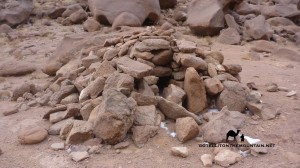 LEOPARD TRAPS – These are common on high mountain passes, but most just look like ordinary heaps of stones. Look closer and you’ll spot a little gap at the front; this was the doorway and it led into a bigger chamber, where the bait would be put. The leopard would trip a wire when it entered, bringing a heavy stone down over the door. Leopards once roamed widely in the Sinai, but it’s thought they’ve been extinct since the 1950s. The closest ones are in the Negev desert of Israel, just over the border.
LEOPARD TRAPS – These are common on high mountain passes, but most just look like ordinary heaps of stones. Look closer and you’ll spot a little gap at the front; this was the doorway and it led into a bigger chamber, where the bait would be put. The leopard would trip a wire when it entered, bringing a heavy stone down over the door. Leopards once roamed widely in the Sinai, but it’s thought they’ve been extinct since the 1950s. The closest ones are in the Negev desert of Israel, just over the border.
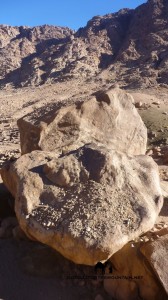 WISHING ROCKS – Up in the mountains, usually on big routes from A to B, you’ll see large boulders covered in small pebbles. These are special wishing rocks and focal points of local superstitions. To make a wish you have to throw a pebble on top of the boulder. And it actually has to stay on top; if it bounces off and falls to the ground, the wish won’t come true. It’s an old tradition of the Jebeleya tribe near St Katherine and the number of wishing rocks is still growing in the area today.
WISHING ROCKS – Up in the mountains, usually on big routes from A to B, you’ll see large boulders covered in small pebbles. These are special wishing rocks and focal points of local superstitions. To make a wish you have to throw a pebble on top of the boulder. And it actually has to stay on top; if it bounces off and falls to the ground, the wish won’t come true. It’s an old tradition of the Jebeleya tribe near St Katherine and the number of wishing rocks is still growing in the area today.
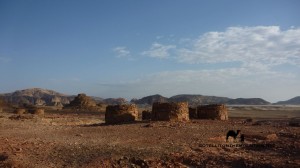 NAWAMIS – These are small, circular tombs, and you’ll see them scattered on high ground in the desert. They were probably built by early mining settlers of the Sinai, as far back as 4000BC. With just a few exceptions, their doors always face west, towards the setting sun; nobody knows why but it probably had an early religious significance. An old Bedouin legend has it Moses and the Israelites built them as shelter from a huge swarm of ravenous insects during their wanderings in the wilderness.
NAWAMIS – These are small, circular tombs, and you’ll see them scattered on high ground in the desert. They were probably built by early mining settlers of the Sinai, as far back as 4000BC. With just a few exceptions, their doors always face west, towards the setting sun; nobody knows why but it probably had an early religious significance. An old Bedouin legend has it Moses and the Israelites built them as shelter from a huge swarm of ravenous insects during their wanderings in the wilderness.
 ROJOMS – These are small piles of trail-marking stones to help you find your way. The Sinai rarely has good trails, being either rocky underfoot or sandy, where trails blow away; rojoms are essential. Small stones are placed one on top of the other in a small pile, like the ones in this pic. Otherwise, they might be single, big stones, stood up themselves. Or any stone that just looks like it couldn’t be in the position it’s in by itself. They’re put at regular intervals, usually on easy-to-see skylines. You can help by repairing damaged rojoms.
ROJOMS – These are small piles of trail-marking stones to help you find your way. The Sinai rarely has good trails, being either rocky underfoot or sandy, where trails blow away; rojoms are essential. Small stones are placed one on top of the other in a small pile, like the ones in this pic. Otherwise, they might be single, big stones, stood up themselves. Or any stone that just looks like it couldn’t be in the position it’s in by itself. They’re put at regular intervals, usually on easy-to-see skylines. You can help by repairing damaged rojoms.
 HERMIT CELLS – These look like any old boulder on first glance. Look closely though and you’ll see an opening. Go in and you’ll find dark hollows to which Christians came for retreat in early ages. Many go back to the Byzantine era, when Christianity flourished. Some go back further, to the time of the Roman persecutions, when thousands of Christians fled to the Sinai to escape the bloodshed. Some have sleeping platforms, shelves for candles; porches, doors and even knockers. They’re brilliant spots to shelter from bad weather and some of the most atmospheric spots to sleep in the Sinai.
HERMIT CELLS – These look like any old boulder on first glance. Look closely though and you’ll see an opening. Go in and you’ll find dark hollows to which Christians came for retreat in early ages. Many go back to the Byzantine era, when Christianity flourished. Some go back further, to the time of the Roman persecutions, when thousands of Christians fled to the Sinai to escape the bloodshed. Some have sleeping platforms, shelves for candles; porches, doors and even knockers. They’re brilliant spots to shelter from bad weather and some of the most atmospheric spots to sleep in the Sinai.
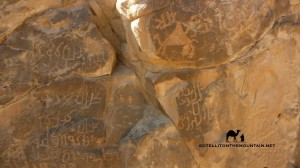 GRAFFITI – You’ll spot writing on rocks all over the Sinai. It looks a bit like Arabic at first; but most of it is Nabataean script, about 2000 years old. It usually records names, short simple statements or prayers. Similarly common are pictures showing hunts, camel caravans, sailing ships and other stuff. There’s plenty of stuff from later on too: look carefully and you’ll find everything from Egyptian hieroglyphics to Roman, Greek and old Arabic script, plus inscriptions from early European travellers.
GRAFFITI – You’ll spot writing on rocks all over the Sinai. It looks a bit like Arabic at first; but most of it is Nabataean script, about 2000 years old. It usually records names, short simple statements or prayers. Similarly common are pictures showing hunts, camel caravans, sailing ships and other stuff. There’s plenty of stuff from later on too: look carefully and you’ll find everything from Egyptian hieroglyphics to Roman, Greek and old Arabic script, plus inscriptions from early European travellers.
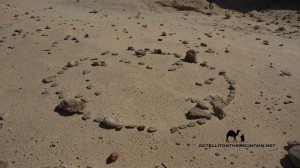 BEDOUIN GRAVES – When the Bedouin died, they’d be buried in simple, easily-made graves. Typically, graves would be marked with a ring of small stones; bigger stones were then placed directly over the head and feet. Sometimes, you see graves like this in known burial areas; but it wasn’t always possible to carry people to designated cemeteries. You also find them near where people died, in the most remote, unexpected stretches of the wilderness.
BEDOUIN GRAVES – When the Bedouin died, they’d be buried in simple, easily-made graves. Typically, graves would be marked with a ring of small stones; bigger stones were then placed directly over the head and feet. Sometimes, you see graves like this in known burial areas; but it wasn’t always possible to carry people to designated cemeteries. You also find them near where people died, in the most remote, unexpected stretches of the wilderness.